In the 11th episode of the third season of Star Trek: Deep Space Nine, a few members of the crew are accidentally sent into the past, and find themselves interacting with important events in Earth's history. In doing so, the series, usually set in the utopian far future where war, poverty, and other social ills have been eliminated, explores a time before that paradise has come into being. The episode, which first aired in January of 1995 (and continued in Past Tense, Part II the next week), looks at a time less than 30 years into the writers' future, when homelessness, hunger, unemployment, and social inequality have reached a breaking point:
"It is one of the most violent civil disturbances in American history, and it happened right here: San Francisco, Sanctuary District A, the first week of September, 2024"
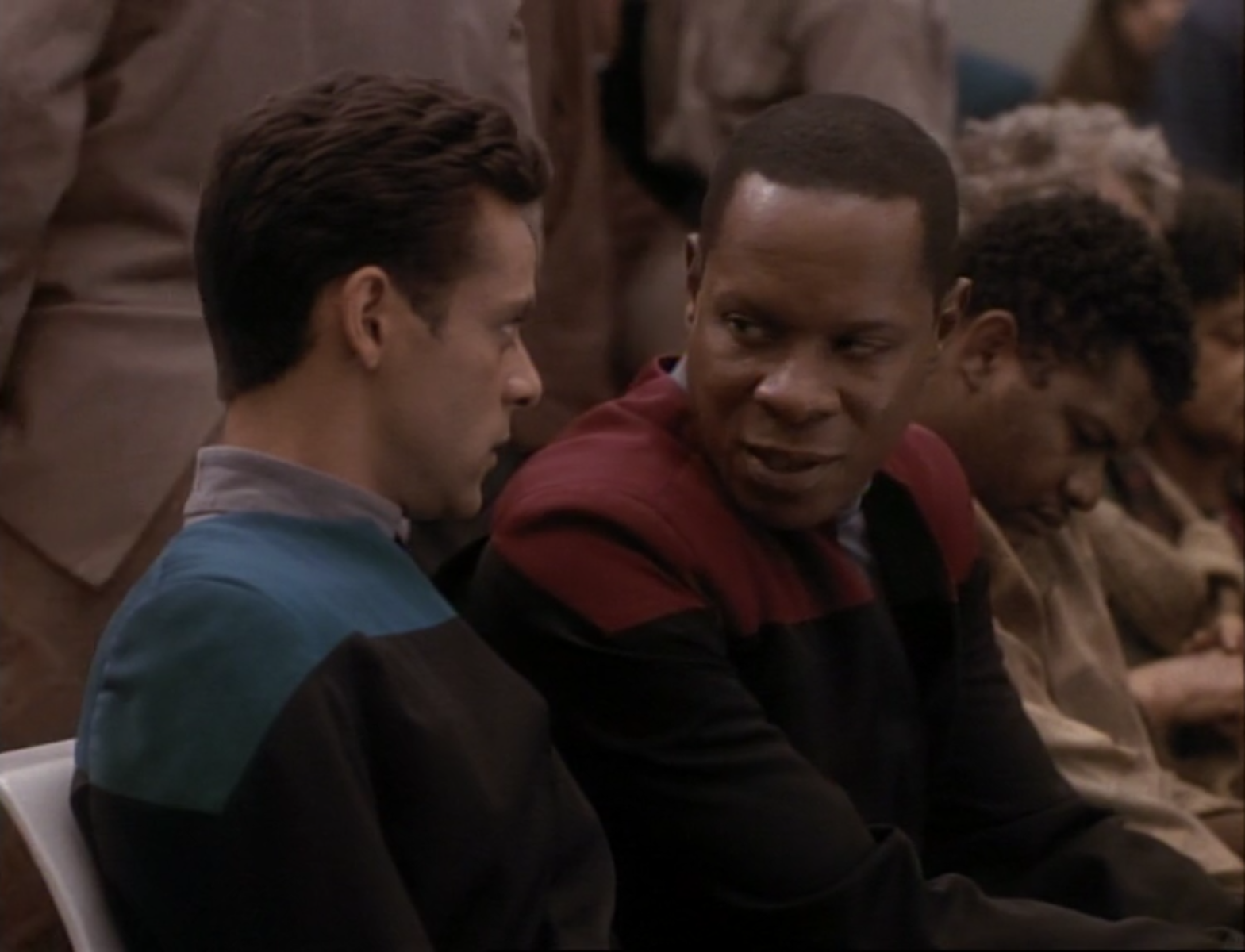
Two more of the crew travel to the past to rescue their lost colleagues, and appear at the corner of Polk and California streets on the evening of September 2nd, 2024, when the Bell Riots are in progress nearby.

And so it was that I made my way to San Francisco this week. Some parts of the Star Trek future might be hard to bring about, but I could make Chief O'Brien appear at that place and time. So I did.
In fact, I've had the notion of doing this for a while - it's been on my calendar for seven or eight years. I bought the commbadge for the costume on sale almost that long ago, and this year I got serious, collecting parts of the costume from thrift shops, mostly, and finding an old tricorder toy online. O'Brien's jacket is very distinctive though, and there wasn't much chance of finding something like it. Instead, a local tailor, Dani Sanders, was able to make me something that looked a great deal like the one seen on-screen. As an extra bonus, it fit me perfectly, as a custom jacket should.
I made a short vacation of it, and my friend James came along for the trip. We flew north to San Francisco on September 1st (about two days after Sisko, Bashir, and Dax would have arrived), and stayed in a hotel downtown. We explored the city by streetcar, bus, and cable-car, and on September 2nd rented bicycles and explored Golden Gate Park, the Presidio, and nearby areas, including the Pacific coast.
Then, in the evening, I put on my costume and we walked a little over 20 minutes to Polk & California. As it turns out, there was a small group of Star Trek fans there taking pictures (which is just what we'd come to do), but I was the only one in 'period' dress.

The people on-site were very complimentary of the jacket, but so, to my surprise, were about half a dozen strangers along the way who called out their approval. At least one recognized it from Star Trek, and cheerfully voiced her enthusiasm for the show.
The next day we rented a car and explored Point Reyes, where the gorgeous weather we'd been enjoying in the city continued. But the fog was rolling in again on the morning of September 4th, as we boarded the Caltrain to leave town. We took the Amtrak Coast Starlight and enjoyed spectacular coastal views, particularly between Lompoc and Ventura, California, and pulled into Los Angeles that evening.
Past Tense and its exploration of social issues is very much in the tradition of Star Trek. In fact, it bears important similarities to one of the most celebrated episodes of the original 1960s series, The City On The Edge of Forever. In both cases, an accidental trip into the past results in our Starfleet crew changing history for the worse - Starfleet, the Federation, and the utopian future are all erased. And in both cases a pair of the time-travellers' shipmates go back in time to rescue them, and to correct the damage to history. Gabriel Bell himself is much like the central character in that episode, too. Like Edith Keeler, Bell lives in a time of poverty and unemployment, and like Keeler he intervenes to care for the vulnerable, but each dies before they're able to make their pivotal contribution to history. (Who is supposed to die, and when, is a difference, of course).
But these two episodes, filmed nearly thirty years apart, aren't the same story. And in some ways, Past Tense is more daring, and explores contemporary issues by extrapolating where then-current social problems might evolve to in 30 years, if steps weren't taken to address them. City, on the other hand, looks comfortably back some three decades to the past (from its 1967 air date), to a time whose social problems seemed to have been overcome, and replaced by an exciting new era of prosperity and technological progress — the space-age future aspired to by Keeler herself in the episode. While City on the Edge of Forever makes drama and suspense of what has changed and how Kirk and Spock will put it right, Past Tense asks the equivalent question, but also presents the viewer with the problem of how to set things right in our own society to avoid the kind of future it shows evolving from our present.
In fact, in the closing scene, when our heroes from the utopian future are reflecting on the 21st-century history they've just relived, the episode speaks almost directly the the audience, reminding us of where the responsibility for the shape of our future lies:
Bashir: "Having seen a little of the 21st century, there is one thing I don't understand. How could they have let things get so bad?"
Sisko: "That's a good question. I wish I had an answer."
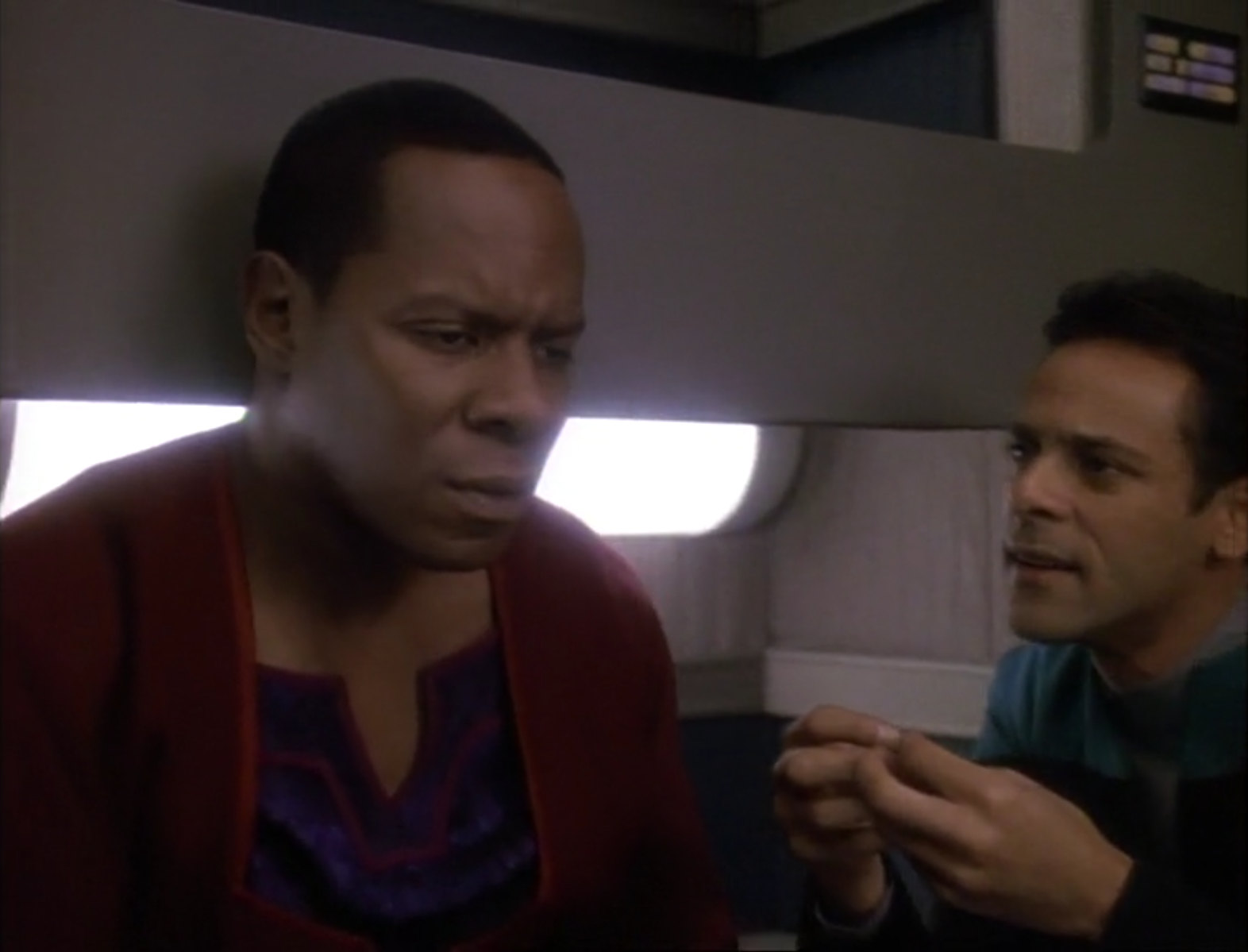
Rewatching Past Tense today, the circumstances of 2024 San Francisco seem familiar, and the writing seems prescient (almost as if the consequences of poverty and inequality are foreseeable). In this way, it's reminiscent of Octavia Butler's novel Parable of the Sower, which was published in 1993 and depicts life in mid-2020s suburban Los Angeles in a way that is a little too close to home. Some details on-screen don't quite fit the actual future — there are no Sanctuary Districts to confine the homeless masses, the US hasn't switched to Celsius for temperature, and Transbay Tube 2 hasn't yet been built. But there are homeless masses, in San Francisco and elsewhere, and the police routinely use unapologetic force to remove them from the street or their encampments. And the Governor of California is demonstrably inclined to use strong measures against the homeless, while taking little action against the causes of homelessness. And in recent years, heavily-armed police have been deployed to seemingly every large protest demanding social progress, often bringing violence against the protesters. We see all these in our real present, in ways reflected clearly in this fiction from 30 years ago.
In posing the challenge of building a better future than it portrays, the episode also gives us a range of role models, who are relatable to the places many of us find ourselves in society. We are all called to be Gabriel Bell: to do what we can, where we are, to protect the vulnerable, and to act to bring about a better future. Commander Sisko himself is quite literally called to do all of these, and with typical Starfleet dutifulness, wits, and skill, rises to the occasion. But in fact Bell is one of the characters we get to know least, beyond his self-sacrifice and heroism. It's another Santuary District resident, Webb, whom we see rallying his neighbours against their oppression, and declaring that "the only help we're going to get is from each other, and if we don't start pulling together, we're finished.", going on to say that for residents who want to get out of the Sanctuary Districts, "the only way that's going to happen is if we get organized!"
By contrast, the bureaucracy that runs the Sanctuary District is very organized and, if underfunded, supported by the apparatus of the state. Vin, the policeman who picks up Sisko and Bashir and delivers them to the district, is overworked and jaded. He does his job and enforces the rules out of a sense of order and duty ("What are you, an anarchist?"), but has no enthusiasm for helping out the people he patrols ("If you've got any problems, don't come to me with them"), and scoffs at Dr. Bashir's assurance "that someday, there won't be a need for places like this". Officer Calvera, his colleague, is similarly resigned to the social problems and power structures he enforces, but more reluctant and without the sense of duty to authority; whether at the end of a long shift or while being held hostage, he just wants to take off the uniform and go home to his family.
Also just doing her job is the social worker who processes people into the district. She once took pity on a new arrival and skipped some processing steps to save them from prosecution, but almost lost her own job for it. She works at a desk covered in paper forms and knows from close observation the suffering and misery that this paperwork documents (and creates), but she feels powerless to change it and works glumly through her days, fully conscious she's a cog in this machine ("I hate it, but that's the way it is").
Outside the sanctuary district, but not truly outside that bureaucracy, is Chris Brynner, the internet and media company CEO. In a familiar sign of the dystopia at hand, the government's oppressive infrastructure runs on his platform, and government users pay his company a subscription to operate the tools that criminalize poverty. He accepts these aspects of his society as a matter of reality, and lives a life of skyscraper offices and cocktail parties, isolated from the poverty of his own city. But when the newsfeeds, and a new friend, confront him with the Bell Riots and what they represent, he eventually (at Dax's urging and persuasion) risks his lucrative government contracts to give a voice to the oppressed, enabling their message to spread widely to the public. In this, Brynner is a role model which our real-world internet and media CEOs seem wholly unlike. But he's also a metaphor for those of us who aren't corporate plutocrats.
In the world of 1995, and today in 2024, where poverty and inequality have advanced to desperate degrees, few of us are as affluent as Brynner. Those who are are almost certainly contributors to, or at the very least benefactors of, that inequality; in a society with growing poverty, the very existence of multibillionnaires is both a cause and a symptom of the problem. For the rest of us who aren't so wealthy, but also aren't desperately poor, Brynner's action is a reminder that progress needs people like Bell and Webb, but it also needs the rest of us to listen, and to add our voices and actions to the movement toward justice and equality.
Like Brynner, it's easy for those of us isolated from poverty to ignore it. We can sleep safely in our houses, travel to work enclosed in our automobiles, and spend the day indoors at our workplaces having little interaction with the people in our own communities whose situation has become desperate, and is still worsening. While today's poor and homeless are not, as it turns out, confined to Sancutary Districts, they are increasingly numerous, and they are often functionally walled away from us, if not literally so. They need, and deserve, our help, only because of that — because they are human and they are suffering and we can help them. But if we need to be urged to help them, we might take a moment to reflect, and to recognize that most everyone, nearly all of us, no matter our financial stability, our education, our job, or our aspirations, are much closer to Bell than to Brynner. If sympathy for the suffering of strangers isn't enough to drive us to help them, maybe seeing how close we are to being like them — one big medical diagnosis, one housing-market crash, one round of layoffs — will. Most all of us, no matter how secure, is closer to being poor than to being a billionnaire. Seeking to draw a distinction, we might be tempted to make explanations for why someone else is living in poverty, but when Bashir asks for one, Sisko gives him the straight answer:
Bashir: "Then what did they do to deserve this?"
Sisko: "Nothing. Just people — without jobs or places to live."
No one deserves to live in the conditions Sisko and Bashir witness, nor in the poverty, homelessness, and sickness our own society faces. People experiencing this deserve our help, because they need it, and because we can help them.
But even if we succeed with sympathy or empathy, there's often another barrier — resignation and powerlessness. Sisko further explains to Bashir:
"It's not that they don't give a damn — they've just given up. The social problems they face seem too enormous to deal with."
The problems can seem distant, or daunting, or beyond our own ability to affect. And if a problem is too big to fix, or we feel powerless to fix it, we can retreat to a sense that we're not responsible for it. Bashir himself tries to comfort the social worker to this effect:
Bashir: "It's not your fault that things are the way they are."
Social worker: "Everybody tells themselves that, and nothing ever changes."
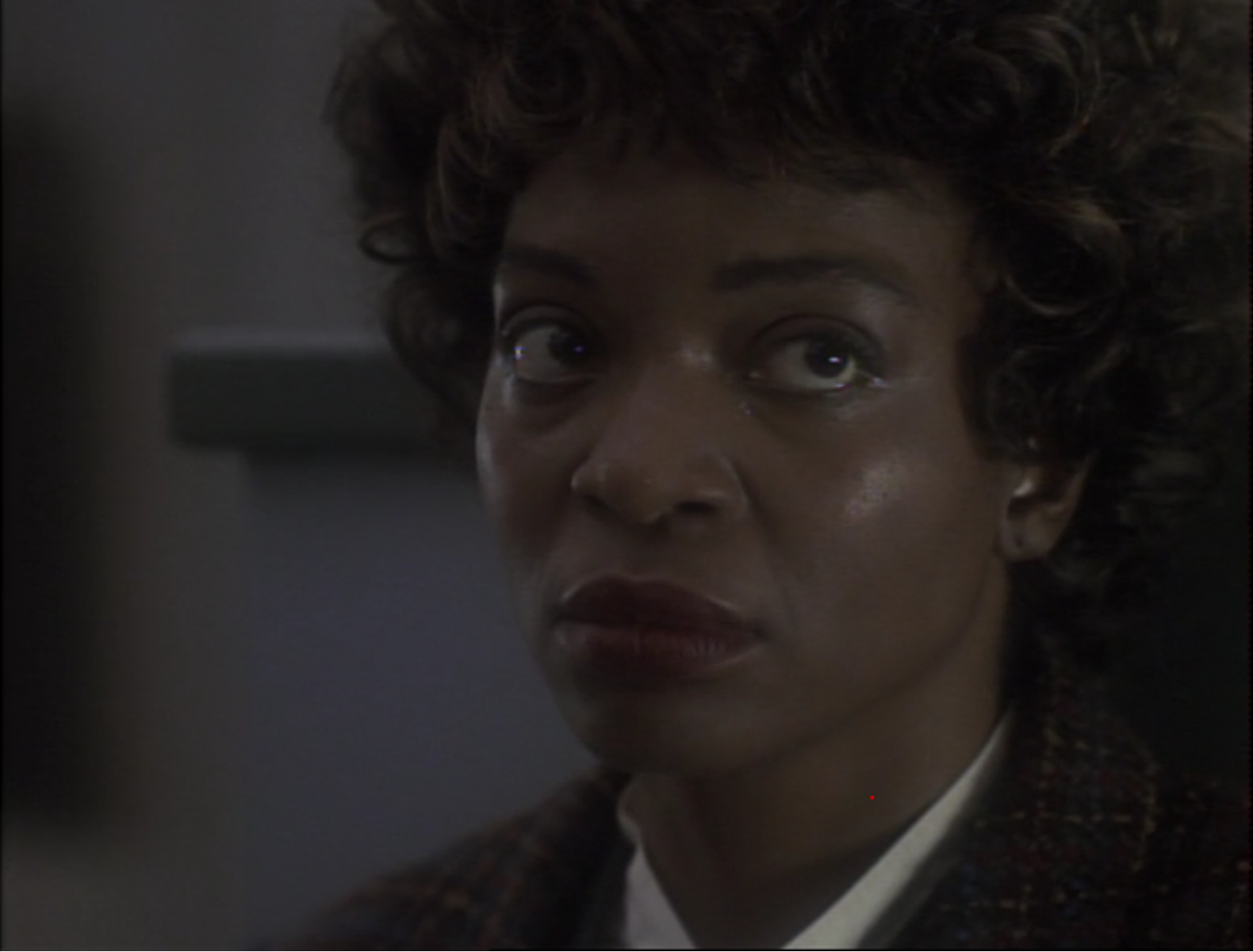
As resigned as she is to her place in life, she knows things have to change. She doesn't see how to change it, but she feels deeply that it needs to get better. She understands, more than any of the other non-sanctuary residents, that we all have a responsibility to build society up, and to care for those society has left behind. This social worker speaks to all of us today, who have jobs and are trying to get by, counting ourselves lucky that we're not among the ones whom society's rising tide is drowning, for their inability to buy a boat.
In The City on the Edge of Forever, Edith Keeler makes a speech which sums up her character, along with the utopian ethos of Star Trek:
"Now I don't pretend to tell you how to find happiness and love, when every day is just a struggle to survive. But I do insist that you do survive. Because the days, and the years ahead are worth living for. One day, soon, man is going to be able to harness incredible energies — maybe even the atom. Energies that could ultimately hurl us to other worlds, in some sort of space ship. And the men that reach out into space will be able to find ways to feed the hungry millions of the world, and to cure their diseases. They will be able to find a way to give each man hope, and a common future. And those are the days worth living for."Words to live up to. But while City makes the passionate case for hope, Past Tense leaves us with a call to action:
Vin: "How could we have let this happen?"
Bashir: "The question is, how do we stop it from happening again?"
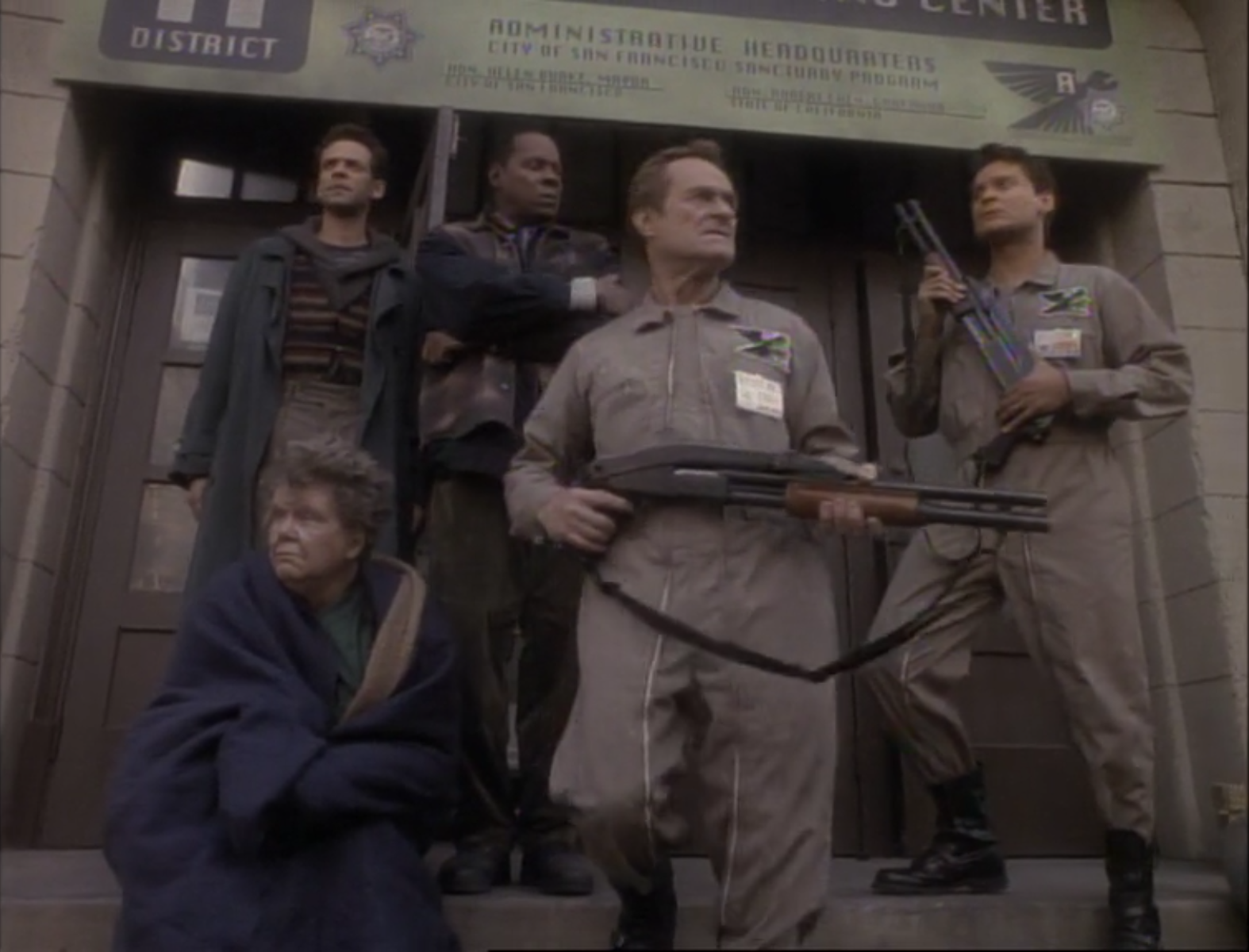
Edith Keeler believes in a beautiful future, and reminds us of the power of hope. Gabriel Bell reminds us that the future we want doesn't come just from hoping and waiting. We have to bring it about ourselves, because the arc of history does not bend towards justice unless we bend it that way. When it comes to poverty, inequality, and indeed most of our great social problems, it's easy to feel resigned to them, even if we imagine, like Keeler, that a better world is coming. But Ben Sisko reminds Vin (and us) that in taking action, the first step is in empathy and sympathy:
Vin: "You want me to say I'm sorry? That they got a bad break? What good would it do?"
Sisko: "It would be a start!"
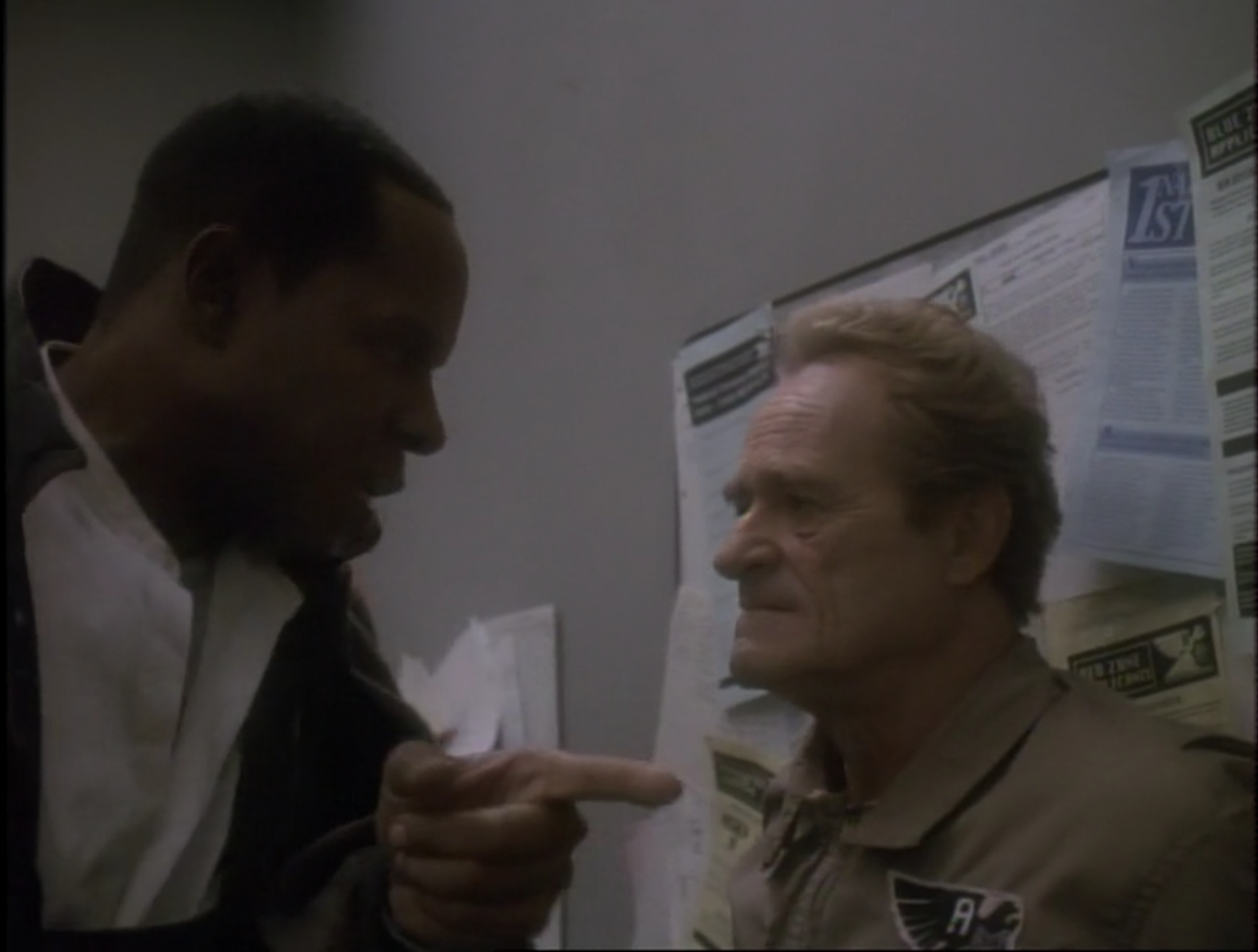
We all have to learn how to work together on the steps which come after. And to dare to have the courage to take those steps. In the first week of September, 2024, Chief O'Brien is looking for Sisko, Bashir, and Dax, and the better future they represent. So am I.
Altadena
2024-09-06
Screenshots from Star Trek: Deep Space Nine are copyright CBS Broadcasting. Included here under fair use to ilustrate the television episode being reviewed.
Images of me in costume kindly taken by James-Michael Peace.